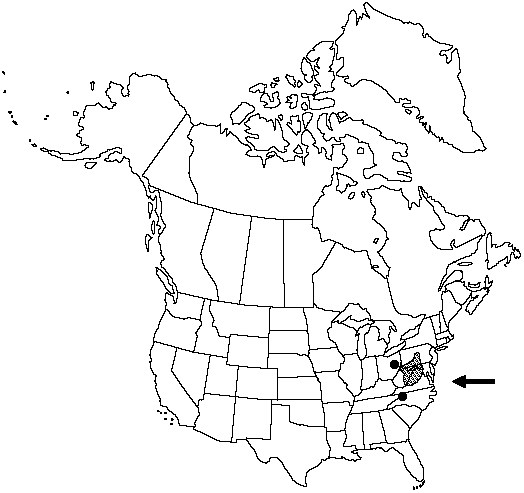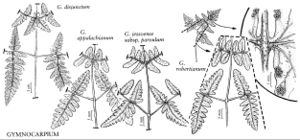FNA>Volume Importer |
imported>Volume Importer |
| (7 intermediate revisions by 2 users not shown) |
| Line 17: |
Line 17: |
| | }}<!-- | | }}<!-- |
| | | | |
| − | --><span class="statement" id="st-d0_s0" data-properties="stem diameter"><b>Stems </b>0.5–1.5 mm diam.;</span> <span class="statement" id="st-d0_s1" data-properties="scale some measurement">scales 1.5–3 mm.</span> <span class="statement" id="st-d0_s2" data-properties="leaf reproduction;leaf some measurement"><b>Fertile </b>leaves usually 10–32 cm.</span> <span class="statement" id="st-d0_s3" data-properties="petiole some measurement;glandular-hair count or density"><b>Petiole </b>6–20 cm, with sparse glandular-hairs distally;</span> <span class="statement" id="st-d0_s4" data-properties="scale some measurement">scales 2–5 mm.</span> <span class="statement" id="st-d0_s5" data-properties="blade shape;blade shape;blade some measurement;blade architecture or arrangement;blade fragility;abaxial surface pubescence;abaxial surface pubescence;abaxial rachis pubescence;glandular-hair count;adaxial surface pubescence"><b>Blade </b>broadly deltate, 2–3-pinnate-pinnatifid, 4–12 cm, lax and delicate, abaxial surface and rachis glabrous or with occasional glandular-hairs, adaxial surface glabrous.</span> <span class="statement" id="st-d0_s6" data-properties="pinna apex architecture or shape;pinna apex shape"><b>Pinna </b>apex entire, rounded.</span> <span class="statement" id="st-d0_s7" data-properties="proximal pinna some measurement;proximal pinna orientation;pinnule orientation;pinnule orientation"><b>Proximal </b>pinnae 3–10 cm, ± perpendicular to rachis, with basiscopic pinnules ± perpendicular to costa;</span> <span class="statement" id="st-d0_s8" data-properties="pinnule orientation;pinnule architecture;pinnule architecture;pinnule shape;pinnule shape;pinnule architecture;pinnulet orientation;pinnulet height or length or size;pinnulet arrangement">basal basiscopic pinnules stalked or sessile, pinnate-pinnatifid or pinnatifid, if sessile then with basal basiscopic pinnulet (division of pinnule) always shorter than adjacent pinnulet;</span> <span class="statement" id="st-d0_s9" data-properties="pinnule orientation;pinnule architecture;pinnule architecture;pinnulet orientation;pinnulet height or length or size;pinnulet arrangement">2d basal basiscopic pinnule infrequently stalked, if sessile then with basal basiscopic pinnulet shorter than adjacent pinnulet;</span> <span class="statement" id="st-d0_s10" data-properties="pinnule orientation;pinnule architecture;pinnule architecture;pinnulet orientation;pinnulet height or length or size;pinnulet arrangement">basal acroscopic pinnule occasionally stalked, if sessile then with basal basiscopic pinnulet shorter than adjacent pinnulet.</span> <span class="statement" id="st-d0_s11" data-properties="pinna architecture;pinna architecture;pinnule orientation;pinnule height or length or size;pinnule arrangement"><b>Pinnae </b>of 2d pair usually stalked, if sessile then with basal basiscopic pinnule shorter than adjacent pinnule and equaling basal acroscopic pinnule;</span> <span class="statement" id="st-d0_s12" data-properties="pinnule orientation;pinnule height or length or size;pinnule arrangement;apex architecture or shape;apex shape">basal acroscopic pinnule shorter than adjacent pinnule, often with entire, rounded apex.</span> <span class="statement" id="st-d0_s13" data-properties="pinna architecture;pinnule orientation;pinnule height or length or size;pinnule variability;pinnule height or length or size;pinnule arrangement;basal pinnule orientation"><b>Pinnae </b>of 3d pair usually sessile with basal basiscopic pinnule shorter than adjacent pinnule and equaling or shorter than basal acroscopic pinnule;</span> <span class="statement" id="st-d0_s14" data-properties="pinnule orientation;pinnule variability;pinnule height or length or size;pinnule arrangement">basal acroscopic pinnule equaling or shorter than adjacent pinnule.</span> <span class="statement" id="st-d0_s15" data-properties="ultimate segment shape;ultimate segment shape;ultimate segment shape;ultimate segment shape;apex architecture or shape;apex shape"><b>Ultimate </b>segments of proximal pinnae oblong, entire to crenate, apex entire, rounded.</span> <span class="statement" id="st-d0_s16" data-properties="spore some measurement;2n chromosome count"><b>Spores </b>27–31 µm. <b>2n</b> = 80.</span><!-- | + | --><span class="statement" id="st-undefined" data-properties=""><b>Stems </b>0.5–1.5 mm diam.; scales 1.5–3 mm. <b>Fertile</b> leaves usually 10–32 cm. <b>Petiole</b> 6–20 cm, with sparse glandular hairs distally; scales 2–5 mm. <b>Blade</b> broadly deltate, 2–3-pinnate-pinnatifid, 4–12 cm, lax and delicate, abaxial surface and rachis glabrous or with occasional glandular hairs, adaxial surface glabrous. <b>Pinna</b> apex entire, rounded. <b>Proximal</b> pinnae 3–10 cm, ± perpendicular to rachis, with basiscopic pinnules ± perpendicular to costa; basal basiscopic pinnules stalked or sessile, pinnate-pinnatifid or pinnatifid, if sessile then with basal basiscopic pinnulet (division of pinnule) always shorter than adjacent pinnulet; 2d basal basiscopic pinnule infrequently stalked, if sessile then with basal basiscopic pinnulet shorter than adjacent pinnulet; basal acroscopic pinnule occasionally stalked, if sessile then with basal basiscopic pinnulet shorter than adjacent pinnulet. <b>Pinnae</b> of 2d pair usually stalked, if sessile then with basal basiscopic pinnule shorter than adjacent pinnule and equaling basal acroscopic pinnule; basal acroscopic pinnule shorter than adjacent pinnule, often with entire, rounded apex. <b>Pinnae</b> of 3d pair usually sessile with basal basiscopic pinnule shorter than adjacent pinnule and equaling or shorter than basal acroscopic pinnule; basal acroscopic pinnule equaling or shorter than adjacent pinnule. <b>Ultimate</b> segments of proximal pinnae oblong, entire to crenate, apex entire, rounded. <b>Spores</b> 27–31 µm. <b>2n</b> = 80.</span><!-- |
| | | | |
| | -->{{Treatment/Body | | -->{{Treatment/Body |
| Line 23: |
Line 23: |
| | |elevation=200–1400 m | | |elevation=200–1400 m |
| | |distribution=Md.;N.C.;Ohio;Pa.;Va.;W.Va. | | |distribution=Md.;N.C.;Ohio;Pa.;Va.;W.Va. |
| − | |discussion=<p>Gymnocarpium appalachianum, restricted to the Appalachian region, is a very local endemic.</p><!-- | + | |discussion=<p><i>Gymnocarpium appalachianum</i>, restricted to the Appalachian region, is a very local endemic.</p><!-- |
| | --><p>Of conservation concern.</p> | | --><p>Of conservation concern.</p> |
| | |tables= | | |tables= |
| Line 33: |
Line 33: |
| | -->{{#Taxon: | | -->{{#Taxon: |
| | name=Gymnocarpium appalachianum | | name=Gymnocarpium appalachianum |
| − | |author=
| |
| | |authority=Pryer & Haufler | | |authority=Pryer & Haufler |
| | |rank=species | | |rank=species |
| Line 47: |
Line 46: |
| | |publication year=1993 | | |publication year=1993 |
| | |special status= | | |special status= |
| − | |source xml=https://jpend@bitbucket.org/aafc-mbb/fna-fine-grained-xml.git/src/287ef3db526bd807d435a3c7423ef2df1e951227/V2/V2_708.xml | + | |source xml=https://bitbucket.org/aafc-mbb/fna-data-curation/src/2e0870ddd59836b60bcf96646a41e87ea5a5943a/coarse_grained_fna_xml/V2/V2_708.xml |
| | |genus=Gymnocarpium | | |genus=Gymnocarpium |
| | |species=Gymnocarpium appalachianum | | |species=Gymnocarpium appalachianum |
| − | |2n chromosome count=80
| |
| − | |abaxial rachis pubescence=glabrous
| |
| − | |abaxial surface pubescence=with occasional glandular-hairs;glabrous
| |
| − | |adaxial surface pubescence=glabrous
| |
| − | |apex architecture or shape=entire;entire
| |
| − | |apex shape=rounded;rounded
| |
| − | |basal pinnule orientation=acroscopic
| |
| − | |blade architecture or arrangement=lax
| |
| − | |blade fragility=delicate
| |
| − | |blade shape=2-3-pinnate-pinnatifid;deltate
| |
| − | |blade some measurement=4cm;12cm
| |
| − | |glandular-hair count=occasional
| |
| − | |glandular-hair count or density=sparse
| |
| − | |leaf reproduction=fertile
| |
| − | |leaf some measurement=10cm;32cm
| |
| − | |petiole some measurement=6cm;20cm
| |
| − | |pinna apex architecture or shape=entire
| |
| − | |pinna apex shape=rounded
| |
| − | |pinna architecture=sessile;sessile;stalked
| |
| − | |pinnule architecture=sessile;stalked;sessile;stalked;sessile;sessile;stalked
| |
| − | |pinnule arrangement=adjacent;adjacent;adjacent;adjacent
| |
| − | |pinnule height or length or size=shorter;shorter;shorter;shorter;shorter
| |
| − | |pinnule orientation=acroscopic;basiscopic;acroscopic;basiscopic;acroscopic;basiscopic;basiscopic;perpendicular;basiscopic
| |
| − | |pinnule shape=pinnatifid;pinnate-pinnatifid
| |
| − | |pinnule variability=equaling;equaling
| |
| − | |pinnulet arrangement=adjacent;adjacent;adjacent
| |
| − | |pinnulet height or length or size=shorter;shorter;always shorter
| |
| − | |pinnulet orientation=basiscopic;basiscopic;basiscopic
| |
| − | |proximal pinna orientation=perpendicular
| |
| − | |proximal pinna some measurement=3cm;10cm
| |
| − | |scale some measurement=2mm;5mm
| |
| − | |spore some measurement=27um;31um
| |
| − | |stem diameter=0.5mm;1.5mm
| |
| − | |ultimate segment shape=entire;crenate
| |
| | }}<!-- | | }}<!-- |
| | | | |
| | -->[[Category:Treatment]][[Category:Gymnocarpium]] | | -->[[Category:Treatment]][[Category:Gymnocarpium]] |
Stems 0.5–1.5 mm diam.; scales 1.5–3 mm. Fertile leaves usually 10–32 cm. Petiole 6–20 cm, with sparse glandular hairs distally; scales 2–5 mm. Blade broadly deltate, 2–3-pinnate-pinnatifid, 4–12 cm, lax and delicate, abaxial surface and rachis glabrous or with occasional glandular hairs, adaxial surface glabrous. Pinna apex entire, rounded. Proximal pinnae 3–10 cm, ± perpendicular to rachis, with basiscopic pinnules ± perpendicular to costa; basal basiscopic pinnules stalked or sessile, pinnate-pinnatifid or pinnatifid, if sessile then with basal basiscopic pinnulet (division of pinnule) always shorter than adjacent pinnulet; 2d basal basiscopic pinnule infrequently stalked, if sessile then with basal basiscopic pinnulet shorter than adjacent pinnulet; basal acroscopic pinnule occasionally stalked, if sessile then with basal basiscopic pinnulet shorter than adjacent pinnulet. Pinnae of 2d pair usually stalked, if sessile then with basal basiscopic pinnule shorter than adjacent pinnule and equaling basal acroscopic pinnule; basal acroscopic pinnule shorter than adjacent pinnule, often with entire, rounded apex. Pinnae of 3d pair usually sessile with basal basiscopic pinnule shorter than adjacent pinnule and equaling or shorter than basal acroscopic pinnule; basal acroscopic pinnule equaling or shorter than adjacent pinnule. Ultimate segments of proximal pinnae oblong, entire to crenate, apex entire, rounded. Spores 27–31 µm. 2n = 80.
Habitat: Maple-birch-hemlock (Acer - Betula - Tsuga) woods on mountain slopes and summits, on moist sandstone or talus slopes with cold air seepage (algific)
Elevation: 200–1400 m
Distribution
Md., N.C., Ohio, Pa., Va., W.Va.
Discussion
Gymnocarpium appalachianum, restricted to the Appalachian region, is a very local endemic.
Of conservation concern.
Selected References
None.

